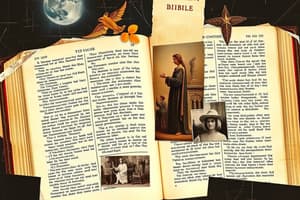Podcast
Questions and Answers
The Bible is often referred to as a 'library of books.' Which of the following best explains why it is described this way?
The Bible is often referred to as a 'library of books.' Which of the following best explains why it is described this way?
- The Bible contains a diverse collection of literary styles, genres, and historical contexts, compiled over centuries. (correct)
- The term 'library' is used metaphorically to emphasize the Bible's central location in monasteries.
- The Bible has been translated into more languages than any other book in the world, making it globally accessible like a library.
- The Bible is physically very large and contains more paper and ink than the average private or public library.
Which statement best characterizes the relationship between the Old and New Testaments?
Which statement best characterizes the relationship between the Old and New Testaments?
- The Old Testament serves as a commentary on the New Testament, providing interpretations of Jesus' teachings for a Jewish audience.
- The New Testament completely replaces the Old Testament, rendering the Old Testament obsolete and irrelevant.
- The New Testament fulfills and builds upon the Old Testament, presenting Jesus Christ as the promised Messiah prophesied in the Old Testament. (correct)
- The Old and New Testaments are completely separate and contradictory collections with no thematic connections.
If someone interprets a biblical passage through a 'literalist' lens, what is the most likely approach they would take?
If someone interprets a biblical passage through a 'literalist' lens, what is the most likely approach they would take?
- Consider the moral implications and ethical lessons presented in the passage.
- Seek to understand the symbolic meaning and deeper truths behind the narrative.
- Analyze the historical and cultural context in which the passage was written.
- Interpret the passage at face value, taking the words in their most straightforward and explicit sense. (correct)
The Bible's history can be understood through which three stages?
The Bible's history can be understood through which three stages?
Which kind of truth would be most applicable when describing the creation story in Genesis?
Which kind of truth would be most applicable when describing the creation story in Genesis?
Flashcards
Old Testament
Old Testament
The Old Testament recounts the history of God's relationship with the Israelites, containing laws, prophecies, and stories.
New Testament
New Testament
The New Testament focuses on the life, teachings, death, and resurrection of Jesus Christ, and the beginning of Christianity.
Covenant
Covenant
A covenant is a sacred agreement or promise between God and humans.
Gospel
Gospel
Signup and view all the flashcards
Moral Truth
Moral Truth
Signup and view all the flashcards
Study Notes
- The Bible is a collection, or library, of books.
- The Bible can be defined as a collection of books considered sacred and divinely inspired.
- It is divided into two main sections: the Old Testament and the New Testament.
- The Old Testament tells of the time before Jesus, and the New Testament is the story of Jesus.
Authorship & History
- The Bible was written by many different authors over centuries.
- The Bible's history includes oral traditions, written accounts, and editing processes.
Old Testament
- The Old Testament is part of the Hebrew Bible.
New Testament
- The central narrative of the New Testament revolves around the life, death, and resurrection of Jesus Christ.
Old Testament vs. New Testament
- The Old Testament precedes the coming of Jesus, while the New Testament focuses on Jesus' life and teachings.
Key Terms Defined:
- Testament: A pact or agreement between God and humans.
- Literalist: Someone who interprets the Bible word-for-word.
- Contextualist: Someone who considers the historical and cultural context of the Bible.
- Patriarch: Founding fathers.
- Covenant: A sacred agreement or bond.
- Gospel: The "good news" of Jesus Christ.
- Christ: The Greek word for Messiah, the anointed one.
- Resurrection: Being raised from the dead.
- Apostle: Someone specifically chosen by Jesus to spread his message.
- Disciple: A follower of Jesus.
Truth in the Bible:
- Religious Truth: Expresses beliefs about God and humanity's relationship with God.
- Moral Truth: Teaches what is right and wrong.
- Symbolic Truth: Communicated through symbols.
- Proverbial Truth: Offered as wise sayings.
- Historical Truth: Verifiable facts about past events.
- Scientific Truth: Knowledge gained through observation and experimentation.
Studying That Suits You
Use AI to generate personalized quizzes and flashcards to suit your learning preferences.
Description
Explore the Bible, a collection of sacred books divided into the Old and New Testaments. Discover its authorship, history, and key narratives, including Jesus Christ's life and teachings. Understand the difference between the Old Testament and the New Testament.




